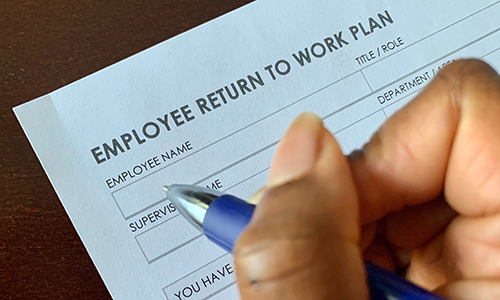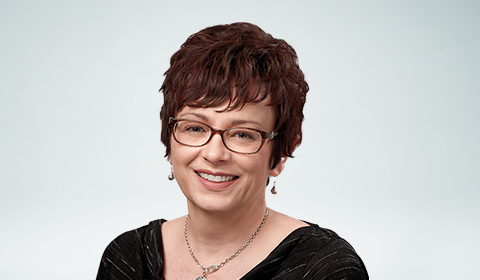As the worst of COVID-19 isolation winds down in many regions of the world, employers are welcoming staff back in person.
This presents a unique opportunity to challenge disability insurers’ historical view of occupational risk and to expand perceptions of the role of insurers in the return-to-work process.
A great deal of uneasiness around returning to the worksite persists for a variety of reasons, some valid and others less justifiable. Layered on top of these concerns is a natural human inclination to avoid change.
During the pandemic, many of us have been removed from the in-person work environment entirely for weeks, months, and sometimes years; this absence only magnifies the fear and anxiety of returning after a serious injury or illness.
Assisting claimants in returning to work has always been a difficult process, long before the world had ever heard of COVID-19. Research shows that anxiety levels in the general population have increased due to a variety of factors: fear of coronavirus infection and severe symptoms; isolation; financial concerns; and sickness and death of family and friends, among others.
A New Occupational Normal
As governments issued lockdown orders, workers whose jobs could be performed remotely transitioned to working from home. Suddenly, this arrangement became more acceptable and a viable option for accommodating many claimants not able to work at the physical job site due to mobility issues, cancer treatment, immunosuppression, or other conditions. In addition, the rise in U.S. wages over the past two years, especially for entry-level jobs, means that claimants may now be able to earn a gainful wage in occupations that earlier could not support a family. In other words, more claimants can now enter viable "alternate occupations".
The pandemic-fueled popularity of remote learning and telehealth also transformed occupations such as nursing and teaching. While many of these professionals have returned to their typical work settings, claimants in such occupations may now be able to work remotely on a temporary or full-time basis if they are unable to return to the classroom or clinic or if they no longer meet the physical demands of in-person work.
Similarly, occupations that once required significant travel shifted to virtual meetings during the pandemic. While business travel may have picked up again, it may never return to pre-pandemic levels. In fact, many employers are now asking if videoconferencing services such as Zoom and Microsoft Teams can offer a feasible alternative to travel as a material and substantial duty.
A Challenge to Rethink Disability Claims
Given these new realities, is it time to rethink how the industry has typically approached return to work in disability claims? It seems reasonable to expect some traditionally hands-on occupations to become less physically demanding, just as we can anticipate employers to become more flexible amid a competitive job market.
Many times, claims analysts and case managers first must address recovering claimants’ fear of returning to work. Highly motivated claimants can overcome these worries independently; other claimants can become entrenched in a self-defeating mindset and may never return to work.
Insurers can have the biggest influence over ambivalent claimants - those who fall in the middle of this behavioral spectrum - by applying insights from behavioral science.
A Behavioral Science-Based Approach
The terms “behavioral science” or “behavioral economics” have become popular buzzwords over the last decade. Behavioral science combines elements of economics and psychology to understand how and why people behave the way they do. While behavioral science has often been used to gain insights into consumer purchasing behaviors, science can just as easily translate to disability claims.
In a recent four-month trial conducted with South Africa-based disability insurer Old Mutual, RGA found that using behavioral science-based goal-setting techniques on claims forms resulted in approximately three-quarters of disability income claimants setting goals.
Most importantly, claims assessors reported that his goal-setting process had a positive impact on claimant engagement and return-to-work motivation.
The results clearly showed that, for a small investment of time, best-practice behavioral science techniques can be incorporated into the various phases of the claims process. The approach is now being rolled out across Old Mutual’s Group Assurance claims team. Read more about the study.
RGA Lead Behavioral Scientist and study co-leader Peter Hovard suggests such an outcome should not be surprising. Low or conflicting motivation can often present a huge barrier to a timely return to work. Motivation is influenced by how individuals perceive their capability and opportunity, so motivation and perceived capability must be the key targets of behavior change interventions.
- One significant source of motivation is the existence and pursuit of goals. Behavioral research shows that when people have a target and get closer to achieving it, they tend to work harder, suggesting that objectives are motivating. The most important aspect of goal setting is that goals must be perceived to be both important and attainable to the claimant; helping claimants set the right goals can be crucial.
- Also, personal commitment is key to achieving an objective. When goals are set by the claimants themselves and reflect their true motivations, they are more likely to be successful. By this logic, those claims or case managers who focus on those goals that are most important to the claimant are more likely to see success. While a claimant’s objectives may not necessarily be specific to return to work, they can nevertheless facilitate this outcome by influencing attitudes and perceptions. For example, a goal to play a particular sport may be the motivation needed to overcome an illness or injury. That same objective may feed the desire to spend time with people again, also motivating a return to work.

As we all know, establishing a goal is rarely enough: a plan for achieving it must follow, particularly where there may be a perceived lack of capability. Insurers should be prepared to identify stumbling blocks and barriers and determine the best approach to overcome them. A few simple steps during the goal-setting process can help:
- Ask the claimant what he or she considers to be a fulfilling life.
- Develop your plan around each claimant’s personal goals and, as he or she improves, introduce questions that address the claimant’s fears and underlying perceptions.
- Build on successes; acknowledge how the claimant has overcome fears.
- Start having return-to-work conversations as you build rapport with the claimant and begin to understand his or her motivations; only then can you truly begin breaking down barriers.
- Remember, human psychology is complex; helping people return to work takes time and patience.
With most disability insurers experiencing increased volumes of claims and staffing issues, ongoing claim management has generally taken a back seat to adjudicate new claims. Now is the time to redirect our focus back to return-to-work efforts. Taking a moment to explore goals and setting a plan for their achievement will go a long way toward returning claimants to more satisfying, gainfully employed lives.




